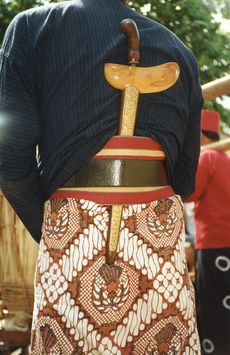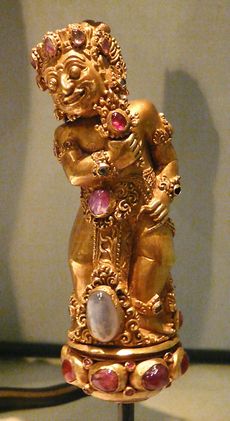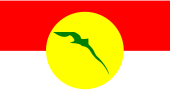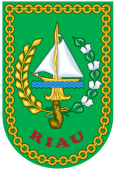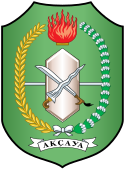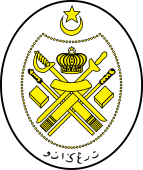كريس (سلاح)
| كريس Kris ꦏꦼꦫꦶꦱ꧀ / ꦮꦁꦏꦶꦔꦤ꧀ | |
|---|---|
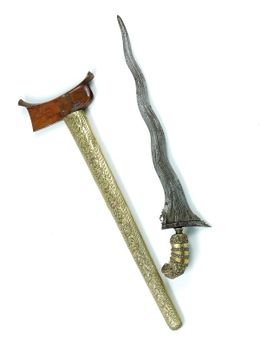 يتكون الكريس من ثلاثة أجزاء؛ النصل(wilah)، المقبض (hulu) والغمد (warangka) | |
| النوع | خنجر |
| مكان الأصل | جاوة، إندونيسيا |
| تاريخ الخدمة | |
| في الخدمة | مملكة سنغاساري، امبراطورية ماجاپاهيت، مملكة أيوتايا، امبراطورية ملقا، سلطنة دماق، سلطنة مطرم، سلطنة يوگياكرتا، سلطنة سوراكارتا، امبراطورية بروناي، إندونيسيا حالياً |
| يستخدمه | الجاويون (الاستخدام الأصلي والرئيسي) * وهو معروف أيضاً لدى الملايو، الفلپينيون، السودانيون، البنجر، Madurese, البالينيون, السياميون, Bugis, Makassar, الخمير |
| الحروب | Pamalayu expedition, Mongol invasion of Java, Battle of Bubat, Majapahit civil war, Burmese-Siamese wars, Siege of Batavia, Diponegoro War, Indonesian National Revolution, Spanish–Moro conflict, Philippine–American War, Pacific War |
| تاريخ الانتاج | |
| أُنتِج | متنازع عليه |
| التنويعات | Kalis, Balasiong, Punyal (Gunong), Chundrik[1] |
| المواصفات | |
| نوع الشفرة | Double edged nickelous iron or steel |
| Hilt type | Ivory, bone, horn, wooden or metals. Sometimes coated with gold or silver and decorated with gemstones |
| Scabbard/sheath | Wooden frame covered and decorated with ivory or metals (gold, silver, copper, iron, brass, or steel) |
| Indonesian Kris | |
|---|---|
 | |
| البلد | Indonesia |
| المصدر | 112 |
| المنطقة | Asia and the Pacific |
| Inscription history | |
| النقش | 2008 |
| قائمة | Representative |
الكريس (ngoko بالجاوية: ꦏꦼꦫꦶꦱ꧀ ;[2] krama inggil بالجاوية: ꦮꦁꦏꦶꦔꦤ꧀;[3] ngoko: الكيريس; krama; dhuwung; krama inggil: wangkingan, حرفياً "للتقطيع"; Minangkabau: karih, Bugis and Makassarese: sele, بالبالينية وSasak: keris, بالجاوية: کريس، التايلندية: กริช krit, Tagalog: kalis, Khmer: គ្រីស kris)، هو خنجر ذو شفرة مميزة وغير متماثلة، من خلال التصفيح المتناوب للحديد والنيكل (pamor).[4] يرتبط الكريس بشكل كبير بالثقافة الإندونيسية. الكريس هو الخنجر الوطني للملايو، مثل الخناجر العُمانية واليمنية، ويحرص الملايو على إظهاره كنوع من الوطنية، وكذلك في المناسبات والأفراح.
التسمية
التاريخ
الأصول



التطور والنتشار

العصر الحديث

الوصف
النصل
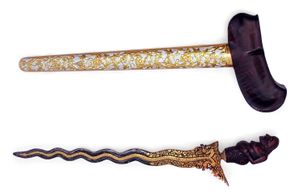
الپامور
المقبض
الغمد
الصقل
المعتقدات الثقافية
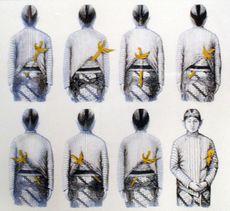

الأساطير

الكريس رمزاً
Flag of Mataram Sultanate
Kris in UMNO flag
Emblem of Riau
Emblem of West Kalimantan
Emblem of Jambi
Emblem of Luwu Regency
Old emblem of Siam
Emblem of Selangor
Emblem of Terengganu
Flag of the Moro National Liberation Front (MNLF)
انظر أيضاً
الهوامش
المصادر
- ^ James Richardson Logan (1853). The Journal of the Indian Archipelago and Eastern Asia, Volume 7. Miss. Press. p. 281.
- ^ Kamus Pepak Basa Jawa, Sudaryanto/Pranowo, 2001, #1359
- ^ See: باللغة الجاوية: Politeness
- ^ Tantri Yuliandini (April 18, 2002). "Kris, more than just a simple dagger". The Jakarta Post. Archived from the original on 29 July 2014. Retrieved 30 July 2014.
قراءات إضافية
- David van Duuren, The Kris; An Earthly Approach to a Cosmic Symbol. Wijk en Aalburg (The Netherlands): Pictures Publishers, 1998.
- David van Duuren, Krisses; A Critical Bibliography. Wijk en Aalburg (The Netherlands): Pictures Publishers, 2002.
- Vic Hurley; Christopher L. Harris (1 October 2010). Swish of the Kris, the Story of the Moros, Authorized and Enhanced Edition. Cerberus Corporation. ISBN 978-0-615-38242-5.
- Gardner, Gerald B., Keris and Other Malay Weapons Orchid Press; Reprint Edition 2010 ISBN 978-974-8304-29-8 (Originally printed 1936 Singapore:Progressive Publishing Company)
- W.H. Rassers, 'On the Javanese kris', in: Bijdragen tot de Taal-, Land- en Volkenkunde 99, 1940, pp. 377–403.
- Victor A. Pogadaev. "Ya Khochu Obruchit'sya s Krisom" (I Want to Be Engaged to a Keris). in: "Vostochnaya Kollektsia" (Oriental Collection). Moscow, Russian State Library. N 3 (30), 2007, 133–141. ISSN 1681-7559
وصلات خارجية
- Surprising find at Okinawa temple – The Star online.
- The Kris in Java and Bali, Indonesia
- OLD BLADES (introducing krises)
